Engineered for life safety!
All you need to know
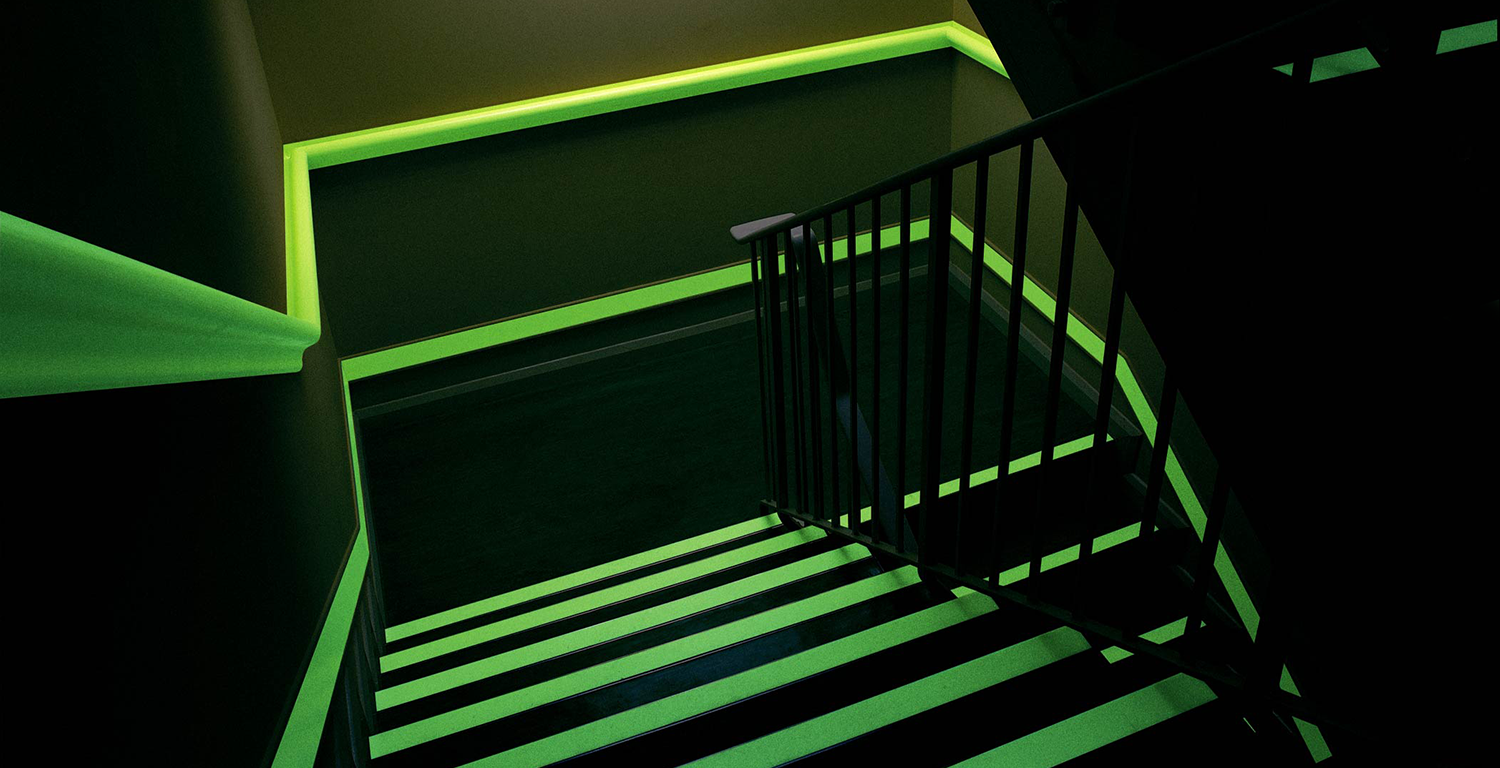
Browse by filter

JALITE - ESCAPE ROUTE SIGNS
JALITE - JALITE - ESCAPE ROUTE SIGNS! Escape route signs, like the fire exit sign, are undeniably the most important sign type. These signs are legally required by The Health and Safety (Signs and Signals) Regulations 1996, and The Regulatory Reform (Fire Safety) Order 2005. Unfortunately, despite the importance of these signs, JALITE regularly see dangerously incorrect versions, installed in many public settings. JALITE have always advocated for and contributed to British and International Standards, designed to address dangerous variants of signs. Hence, we thought we would dedicate this newsletter to BS 5499-4:2013. This standard is for the code of practice and design of escape route signs, like the fire exit sign. BS 5499-4:2013 is the best practice recommendation; encouraging uniformity, proven to create familiarity of escape route signs for occupants, visitors, and the public. Below, you will find key features of JALITE AAA photoluminescent escape route signs, designed according to BS 5499-4:2013. However, first we thought we would highlight what escape route signs are, and why this sign type is fundamental to minimising risks. What is an Escape Route Sign? According to BS 5499-4:2013, an escape route sign is a combination sign, consisting of the emergency exit sign, accompanied by supplementary text, and a safe condition directional arrow. The ‘Emergency exit sign’ mentioned above, is the running man graphical symbol as specified in BS EN ISO 7010:2020+A6:2023. Without combining all three components, especially the emergency exit sign (running man), this cannot conform to standards; the recommendations based upon legislation. Escape route signs, can either be an ‘Exit’ sign, used in every day situations to exit the building, or a ‘Fire exit’ sign, a sign that leads evacuees to a place of safety, usually during an emergency evacuation or situation. Escape route signs should direct occupants along the shortest and safest route to the final exit, during an emergency. This is a legal requirement under The Regulatory Reform (Fire Safety) Order 2005. Example of Non-Conforming Escape Route Sign VS Conforming Escape Route SignMandatory Fire Safety Notices for Fire Doors The fire exit signs installed in the above image do NOT conform to BS 5499-4:2013 for the following reasons: Supplementary text all in uppercase letters Supplementary arrow facing down, indicating a change of level to the final exit Mounting height is below at least 1.8m from floor level. These signs installed can potentially cause delay and confusion, as they deviate from the Standards, that extensively research human behaviour and comprehension of signs, in emergency situations. This can therefore increase risks to evacuees’ life safety. Do you notice anything else from the image that does NOT conform to BS 5499-4:2013? Escape route sign - Meaning 1. Progress down from here (indicating change of level). The fire exit sign JALITE would recommend be used. Escape route sign - Meaning 1. Progress forward from here (indicating direction of travel). 2. Progress forward and through from here, when sign is sited above a door (indicating direction of travel). 3. Progress forward and up from here (indicating change of level). JALITE AAA Photoluminescent Escape Route Signs As JALITE Authorised Distributors, you can have complete assurance, that all JALITE AAA photoluminescent escape route signs are designed according to BS 5499-4:2013. JALITE AAA photoluminescent escape route signs conform to the following recommendations within Standards: Green safety colour to indicate safe condition Supplementary text Emergency exit sign (running man) Supplementary arrow As a JALITE Authorised Distributor, you also get exclusive access to photoluminescent signs that have slower degradation, when compared to other photoluminescent products on the market. This essentially means that during an emergency evacuation, with smoke filled or blackout conditions, JALITE escape route signs, will be visible for longer, giving evacuees more time and guidance to escape. With JALITE AAA photoluminescent escape route signs, your customers are reassured that you are working to best practice, prioritising quality, doing all that you can to keep them and their occupants. JALITE Escape Route Signs CLICK HERE TO OPEN Contact us! If you would like more information on conforming to BS5499-4:2013, please contact us at sales@jalite.com or +44(0) 1268 242 300.

Fire Door Safety Week!
JALITE - Fire Door Safety Week! Fire Door Safety Week is upon us once again, when JALITE join the campaign that pursues educating the masses on the vital role of fire doors, in protecting life and property safety. This pursuit continues for the 11th year, after research last year revealed that 57% of the British public could not identify a faulty fire door, over half of the population. Further research from the British Woodworking Federation discovered that of those who could identify a faulty fire door, 49% would not feel it their responsibility to report known issues. This research provides clear insight into the mindset we have culturally about the importance of fire doors, for our life safety. This is especially eye opening, after phase 1 of the Grenfell Inquiry stated that compromised fire doors were a significant factor in the spread of the fire that ended in tragedy. JALITE in support of Fire Door Safety Week, recommend extending the scope of the campaign to an area of particular concern of ours, mandatory fire notices for fire doors. We more than most, understand the struggle in campaigning for a type of fire safety equipment that although vital in minimising risks for occupants, is often overlooked. In the 4 decades we have been advocating for best practice in the design and development of fire safety notices and signs, we have been privy to signs that are dangerously confusing. Below, we will delve into common misconceptions we see in the design of mandatory fire notices, as well as highlight our range of JALITE photoluminescent mandatory fire notices for fire doors that comply to legislation and conform to standards. However, before this, we felt it pertinent touch on why Fire Door Safety Week is so important. Why is Fire Door Safety Week so important? Fire Door Safety Week endorses educating people on specifying, supplying, installing, operating, inspecting and maintaining fire doors. Fire doors are an essential form of passive fire protection, designed if maintained, to stop the progression of fire for a minimum of 30 minutes. Unfortunately, in many cases fire doors are damaged or in disrepair, propped open or broken. This is confirmed, in the case of the Grenfell fire tragedy, many of the fire doors installed, required further maintenance and were either left open, or had malfunctioning self-closers, at the time the fire ignited. The Fire Safety (England) Regulations 2022 was introduced to combat this, demanding quarterly inspections of all fire doors, whilst imploring residents to raise faults and damages for fire doors immediately. Fire Door Safety Week is the time to educate those residents and the wider public, who occupy environments such as hospitals, offices, and factories. Common Misconceptions: Mandatory Fire Safety Notices for Fire Doors Despite our efforts in encouraging compliance and conformance in the realm of fire safety notices and signs, we still find signs and notices that are incorrect, but popular. This includes in the type of material used, as well as the colours and shapes of the notices and signs. A popular mandatory fire notice for fire doors we see throughout the industry, is one that is printed on stainless steel, aluminium or other metal substrates. Contrary to industry opinion, fire safety signs and notices must be printed on either white PVC (with emergency lighting) or photoluminescent PVC. Thus, installing metal fire notices is ill advised, as under The Health and Safety (Signs and Signals) Regulations 1996 all safety signs (notices) must maintain their intrinsic values. However, metal substrates cannot withstand the temperatures from fires to maintain intrinsic values, i.e. maintain the safety message. One of the most prolific mandatory fire door notices is the ‘Fire exit keep clear’ notice. The popular design we see throughout the industry is the ‘fire exit’ section in green and the ‘keep clear’ in blue. The notice often seems to be produced in a rectangular shape rather than a blue circle as recommended by British and international standards. This gives a misconception that the notice is a combination sign, diluting the meaning of one of the most important signs that evacuees use to egress to safety during an emergency, the fire exit sign. Combination notices and signs are only used to improve comprehension of the safety message. But the green and blue non-conforming version has potential to cause confusion, inconsistent with the research-backed design by international Standards. In the era of fire safety where reporting on competency of responsible and appointed persons is recorded and regulated, why install notices and signs that can be called into question? CLICK HERE TO OPEN JALITE Photoluminescent Mandatory Fire Notices for Fire Doors JALITE is your reliable source for quality mandatory fire notices fire doors, as we use our experience as committee and association leaders to inform all that we do. JALITE photoluminescent mandatory fire notices for fire doors are designed with the following properties that you can use as your basic personal checklist of recommendations: Blue circle shape to signal mandatory instruction to conform to BS ISO 3864-1 Supplementary text type to conform to BS 5499-10 Photoluminescent class c+ luminance performance to conform to DIN 67510 Self-extinguishing as tested by DIN 53438-3. Do your part to educate the masses this Fire Door Safety Week, increasing public awareness of the correct mandatory fire notices for fire doors. This not only encourages familiarity, but also allows residents to confidently advocate for themselves and their safety, as policy around fire doors now calls for. Specify and install JALITE photoluminescent mandatory fire notices for fire doors, to ensure best practice; doing all that you can to minimise the risks that ensue when fire doors aren’t labelled and are faulty, obstructed and propped open. Contact us! If you need any further information on mandatory fire notices for fire doors including literature for use on the go, please contact sales@jalite.com or +44 (0)1268 242 300.
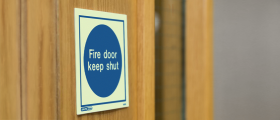
Legislation on Fire Doors
Over the last 40 years JALITE have unfortunately been privy to devastating tragedies that have led to the loss of lives for people within their homes. From Lakanal house to Grenfell, there have been clear shortfalls that through miseducation and negligence have had dreadful consequences. Since our inception, JALITE have always been advocates of good practice, with the three elements of fire safety, compliance, conformance and competence underpinning all that we do. As part of this campaign, we believe in going beyond the minimum requirements to providing prescriptive guidance that give responsible and appointed persons the best opportunity to protect lives and property. This week, the 14th June marks seven years since Grenfell which led to the loss of 72 lives, that rightfully caused a shift in fire safety. The Inquiry highlighted clear shortfalls in fire safety, with the government since introducing legislation in phases to protect against such a loss from happening again. One significant factor in the spread of fire found by the Inquiry, was the inadequacies of the fire doors installed. The Fire Safety (England) Regulations 2022 has since been designed to equip responsible persons and residents with the confidence to mitigate the risks that ensue when fire doors are compromised, which includes regular inspection of this vital fire protection equipment. As endorsers of the full approach, we would recommend achieving this through the installation of adequate fire safety notices for fire doors. Below, you’ll find our full range of JALITE AAA photoluminescent fire safety instruction notices for fire doors, designed to instruct occupants such as residents and visitors. However, first we will touch on legislation on fire doors. Legislation on Fire Doors since Grenfell As mentioned, a significant finding from the Grenfell Inquiry, was that many of the fire doors installed, required further maintenance and were either left open or had malfunctioning self-closers, at the time the fire ignited. Fire doors are essential for preventing the spread of fire and toxic gases through compartmentation. Unfortunately, as the fire doors within Grenfell were compromised, the fire was not contained to the floor level the fire started on. To combat this moving forward, The Fire Safety (England) Regulations 2022 made it a legal requirement for responsible persons for all multi-occupied residential buildings in England over 11 metres to: a) Perform quarterly inspections of all fire doors b) Perform annual inspection of all flat entrance doors. Essentially, as part of The Fire Safety Order 2005, the scope of the fire risk assessment must extend to fire doors; ensuring that responsible persons have completed checks. Responsible persons are also required to provide residents with information on fire doors including stressing the importance of keeping the fire doors shut and obstruction free, raising any fault or damage to the fire doors immediately. Thus, deepening their understanding of their role in keeping the building safe. CLICK HERE TO OPEN JALITE Photoluminescent Fire Safety Instruction Notices for Fire Doors Although The Fire Safety (England) Regulations 2022, focus namely on the inspection of the physical aspects of the fire doors, JALITE recommend going beyond this to fortify the life safety of residents and visitors of these multi-occupancy buildings. This good practice approach that JALITE encourages, recommends installing fire safety instruction notices on each fire door, as part of the inspection and maintenance of the fire door. The installation of fire safety instruction notices for fire doors including ‘Fire door keep shut’, and ‘This door must be kept closed' is integral to instructing building residents and visitors, as to the best way to operate the fire doors. JALITE photoluminescent fire safety instruction notices, are designed to conform to Standards including BS ISO 3864-1 and BS 5499-10 for the blue safety colour, circle shape and text type. Installation of JALITE photoluminescent fire safety instruction notices are an essential part of the fire safety procedure and education that responsible persons are legally required to provide to residents, as per the legislation. JALITE is a trusted source for responsible persons to deter the misuse of fire doors, with obstructions that compromise the effectiveness of this vital equipment. JALITE your trusted source Remembering Grenfell invokes us to remember the responsibility we hold, from supplier to installer to protect the lives of those who trust us to be competent. By going beyond minimum requirements, JALITE can assure that you are complying to legislation, with conformance to Standards, which serves as additional guidance to best practice. Contact us! If you need any further information on this legislation or on our range of JALITE AAA photoluminescent fire safety instruction notices, contact us at sales@jalite.com or +44 (0)1268 242 300.
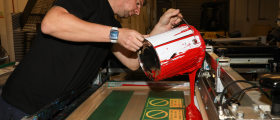
JALITE: Made In Britain
Despite our reach across the world today, JALITE began and grew from the work of one family and small team in Britain. We have been manufacturing JALITE AAA class C+ photoluminescent fire safety signs for decades, helping to protect the life safety of evacuees worldwide. The revolution in fire safety in our earliest days, saw the introduction of legislation designed to protect people and property, especially in industrial, commercial, and marine environments. With new beginnings came a call for guidance and recommendations for the design, commissioning, and installation of fire safety signs. Within the setting of Britain, there was a demand for more prescriptive guidance for fire safety signs, forcing the development of British Standards for fire safety signs that identified, informed, instructed, and located risks. JALITE was positioned to help to inform the British Standards through our in-house research and development of technology, using real life application as our premise. Our background of in-house scientists and marketing professionals, alongside co-ordination with external experts created a recipe for quality technical information to deliver to the fire safety industry. Since, we have used the same principles, working with, and supporting homegrown businesses who also endorse quality, whilst incorporating both international and British requirements for safety. As we mark St. George’s Day this week and celebrate our English heritage as a family run business, we thought we would touch on our commitment to working with other British manufacturers, though our involvement in the Made in Britain community. However, first we thought we would highlight what Made in Britain is and what the trademark represents for consumers and other companies. Who are Made In Britain? Made In Britain is a support for British manufacturers as the trademark helps to verify the origin of British products. In doing so, Made in Britain helps to bring together the manufacturing community, through collaboration with other trade bodies and government departments in the UK. Since its origins in 2013, Made in Britain has worked to promote and celebrate the best in British manufacturing, allowing for transparency for end users looking to get products manufactured on their own doorstep. JALITE authorised distributors through us, are also doing their part to support local businesses. JALITE Photoluminescent Products & Sustainability Made in Britain trademarks naturally encourages sustainability, with homegrown members declaring their manufacturing processes, policies, initiatives, and certifications. Declaration of origins of manufacturing materials and processes is imperative as the world moves towards sustainability in all areas of industry. This is even more integral on British soil, as the UK government commits to ensuring the UK is net zero by 2050. This commitment to removing emissions to lessen the effects of global warming, has rippled to all areas of industry, particularly manufacturing, with policies designed to decarbonise the sector. In addition to working with local businesses as part of our manufacturing process and involvement in Made in Britain, JALITE AAA class C+ photoluminescent material is an alternative sustainable solution to protecting life safety. Our JALITE AAA photoluminescent material negates the need for additional lighting, using existing surrounding lighting for activation, with high optical brightness from even low levels of light. Hence, JALITE photoluminescent fire safety signs help to facilitate the safe egress of evacuees when they need it most. JALITE also use a flame retardant, self-extinguishing recyclable PVC backing for all our JALITE AAA class C+ photoluminescent material. All of this coupled with the JALITE commitment to working with British businesses, subsequently reduces our overall footprint, and yours too by extension. The JALITE team JALITE PLC has always been a UK based customer services team, equipped to provide you all the technical information that is pertinent to you. This includes a collection of marketing literature, instructions on how to install our photoluminescent products, and much more shared exclusively with JALITE authorised distributors. Our UK based customer services team, are up to speed with emerging fire safety legislation to help responsible and appointed persons reach compliance. With this, we can ensure conformance to the guidance that the legislation references as the best code of practice for fire safety signs. JALITE are dedicated to helping you grow your business as we facilitate the justification and specification of JALITE products. JALITE have a UK based production team that have a combined 117 years of experience of manufacturing fire safety signs between them. JALITE printers are some of the few individuals in the UK that are professionals in the dying art of screen printing, producing the best quality print for fire safety signs. This printing style is known throughout the industry to promote durable and legible fire safety signs as required by legislation. This combined with the technical knowledge of phosphorescent pigments and products, produces JALITE AAA class C+ photoluminescent fire safety signs that have a 30+ year shelf life, available in both rigid and vinyl. JALITE PLC despatch team is based in the UK, meaning you can expect standard JALITE products to arrive with you within 1 to 4 working days. Contact us! If you have any questions about Made in Britain or if you need any further information, please contact us at sales@jalite.com or +44 (0)1268 242300.

JALITE Sign Survey!
JALITE Sign Survey! Throughout our 40-year history, JALITE have campaigned tirelessly to impress upon the fire safety industry, the importance of fire safety signs in protecting life safety. Despite the legal requirement for fire safety signs, this vital piece of fire safety equipment has often been an afterthought. For JALITE, fire safety signs are our life. We understand through our own in-house research and development, involvement in setting British and International Standards, and from the outcomes of research into human behaviour during an emergency, how integral fire safety signs are. Moreover, when these signs are designed poorly, installed incorrectly, missing, or unmaintained, the risks to people and property only develop further. JALITE authorised distributors naturally share this same passion for quality fire safety signs, understanding how imperative safety signs are in deterring delays, and allowing evacuees to egress safely with efficiency. JALITE are looking for individuals who through completing sign surveys can be hailed fire safety sign specialists. Essentially, JALITE are looking to support individuals that can specify and/ or install fire safety signs with a methodical approach, with the confidence to advise end users in industrial and commercial and housing settings. These individuals go beyond to exceed recommendations that arise from formal fire risk assessment, working towards both compliance and conformance. In our pledge to get more feedback from you this year to build upon our services for you, we want to hear from you to determine your current capabilities to complete sign surveys. As with this information, we can then filter new business enquiries straight to you. We would also like to know if you would be interested in developing the knowledge necessary for sign surveys, which JALITE plan to facilitate. Below we will provide JALITE sign survey worksheet, with our recommended fire safety signs usually suggested for compliance. The worksheet also doubles as a resource that eases the ordering process with us for the required signs, if applicable. However, before we provide this, we thought we would touch on what a sign survey is and why the are needed. What is a Sign Survey? A sign survey is a comprehensive report to identify safety sign deficiencies within certain areas such as hospitals, factories, warehouses, retail environments etc. Responsible Persons such as building owners will often enlist the help of a sign surveyor, to begin to meet the requirements and significant findings of the formal fire risk assessment, In essence, the sign survey is a way to fulfil compliance of The Health and Safety (Signs and Signals) Regulations 1996, which mandates that safety signs be sited to minimise potential risks based upon the unique hazards of a particular environment. Sign surveys require a specialist confident in their knowledge of fire safety signs, especially as surveying is often conducted within huge multi-level areas with unique and complex potential risks. Thus, surveyors are required to be competent, confident, and knowledgeable to ensure compliance. The sign survey must encourage consistency and uniformity that identifies, informs, instructs, and locates hazards through the following: Designs of signs Location of signs Distances between signs Sign sizes Sign types Safety sign heights. At JALITE we are notorious for combining the compliance to legislation with conformance to Standards for best code of practice, recommending the use of following photoluminescent fire safety signs: Escape route signs. Mandatory signs Prohibition signs Firefighting signs Warning signs. Click Here to open JALITE Authorised Distributor Sign Surveyors JALITE are always inundated with enquires and requests for sign surveys from end users- your potential customers. However, as a manufacturer our only aim is to support our country wide network of authorised distributors by passing such enquiries to those who have individuals that are sign surveyors. Since our beginnings, we have strayed away from competing with our authorised distributors operating fairly by distributing work by region and your existing relationships, to filter enquiries straight to you, to help you further your business. In order to exclusively pass requests for sign surveys straight to you, please let us know if you currently have a sign surveyor on your team. JALITE Sign Survey Training If you are a JALITE authorised distributor that does not currently provide sign surveys and are interested in developing this area of your business, we want to hear from you too please. We are in the process of developing a programme as part of career development, that will equip your team with the competencies needed to complete sign surveys. With demands for Responsible Persons, service and maintenance providers, and installer’s to work together to record competencies, compliance and conformance, JALITE sign survey training is the perfect opportunity to build upon knowledge. In the current climate, it will only provide further confidence for your team, with hopes for building long term business and relationships with your existing and prospective customers. Contact us! If you have any questions about sign surveys or would like to take part in our training as part of career development, please contact us at sales@jalite.com or +44(0) 1268242300 for more information.
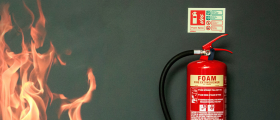
Fire Extinguisher Identification Signs
JALITE Photoluminescent Fire Extinguisher Identification Signs This month has been one for going back to basics, with one of the most prolific fire safety signs for JALITE, the fire extinguisher identification (ID) sign. As we touched on previously, our history and success can easily be tied to our design of the fire extinguisher ID, which became the blueprint for this sign type, widely used today. With popularity of the fire extinguisher ID sign, also came alternative designs for the sign, which went against the very Standards that legislation referenced for guidance. JALITE have informed legislation and contributed to Standards since our origins 4 decades ago, naturally becoming advocates for best practice and quality, in all that we do. This undoubtedly extends to the design and manufacturing of JALITE photoluminescent fire extinguisher ID signs. With this interest in mind, we thought we would highlight the design properties of ID signs, to allow a recap, and to do our part to ensure that Responsible Persons can protect people and property, through specifying and installing compliant and conforming designs. We previously discussed specialised fire extinguisher ID signs. But this week, our emphasis is on standard fire extinguisher ID signs for the tried-and-true fire extinguishers, accepted throughout the industry. Below you’ll find some literature for JALITE fire extinguisher ID signs, a tool for a refresh on fire extinguisher ID signs, especially for new starters. However, we’ll first go into the fundamentals, briefly explaining what fire extinguisher ID signs are and why the signs are needed. Why are Fire extinguisher ID signs Needed? Fire extinguisher ID signs are a vital piece of fire protection equipment that help to locate, identify, instruct, and inform trained personnel, on how to select and operate the fire extinguisher. Fire extinguisher ID signs are designed to meet the unique requirements of The Health and Safety (Signs and Signals) Regulations 1996. In essence, the fire extinguisher ID signs facilitate the mitigation of significant risks to health and safety, therefore people and property, often after recommended after formal risk assessment. In order to appropriately label the fire extinguisher, ID signs must therefore coincide with the classification of fire whether: Flammable solids Flammable liquids Flammable gases Combustible metals Electrical equipment Cooking oils In the event where the fire extinguisher is mislabelled, put in the incorrect place, or labelled with fire extinguisher ID signs that are non-conforming to recommendations, delays can be deadly. Click here to open JALITE photoluminescent fire extinguisher Identification Signs JALITE photoluminescent fire extinguisher ID signs are your solution to combining the requirements of compliance and conformance. Our photoluminescent fire extinguisher ID signs are designed to the colour coding of BS 5306-10;2019 and to BS EN 3, to match the body of the fire extinguisher. To encourage familiarity, and therefore quick response times for trained personnel, JALITE photoluminescent fire extinguisher ID signs also contain the graphical symbol as per BS EN ISO 7010: 2020: A7+2023. JALITE standard photoluminescent fire extinguisher ID signs are available within 1 to 4 working days including: Water- A class wood paper and textiles fires Carbon Dioxide for B class flammable liquids and live electrical equipment fires Foam for A class and B class fires ABC Powder for A, B and C class fires and live electrical equipment fires Wet Chemical for A and F class fires JALITE photoluminescent M2 Powder fire extinguisher ID signs are now updated to the signal violet colour for D class fires, as recommended in BS 5306-10:2019. All JALITE photoluminescent fire extinguisher ID signs are available in our ID size (100 x 150mm) and M size (80 x 200mm), manufactured on JALITE AAA class C+ photoluminescent rigid PVC or self-adhesive vinyl. This undoubtedly helps Responsible Persons and installers to minimise risk, with JALITE photoluminescent signs that help locate, identify, instruct, and inform regardless of lighting and smoked filled conditions. Personalised JALITE Photoluminescent Fire Extinguisher Identification Signs To help you with additional marketing, all standard JALITE photoluminescent fire extinguisher ID signs are easily personalised to feature your company information. Personalised fire extinguisher ID signs can be customised to include the following: Company name Telephone number Email address Barcodes and logos can also be added to standard JALITE photoluminescent fire extinguisher ID signs. Existing JALITE customers of personalised fire extinguisher IDs have found that customisations, encourage repurchase from their existing customers, and new business from perspective customers who can order directly through you. JALITE personalised photoluminescent fire extinguisher ID signs are available to be despatched within 7 to 10 working days. Personalised JALITE photoluminescent fire extinguisher ID signs must be ordered in quantities of 400 pieces of each design. Alternatively, if you prefer to order for your yearly requirements, we can accommodate 12 monthly orders, that can be based on your monthly average orders of fire extinguisher ID signs. Despatch of such purchase orders can be arranged for a set date, for each month (subject to trade indemnity credit facilities). Contact us for more information on JALITE photoluminescent fire extinguisher ID signs, whether personalised or standard. Our customer services team will be happy to help you at sales@jalite.com or +44(0) 1268 242 300 today.
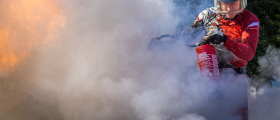
Specialist Fire Extinguisher ID signs
Specialist JALITE Photoluminescent Fire Extinguisher Identification Signs JALITE were the official inventors and developers of fire extinguisher identification (ID) signs, way back in the 90s. Our design for photoluminescent fire extinguisher ID signs was created to satisfy the unique requirements of The Health and Safety (Safety Signs and Signals) Regulations 1996 and was the blueprint for the widely used design for ID signs that we see today. With this precedent, alongside our role in the development of standards for safety signs, we are naturally obligated to provide JALITE recommendations for existing and emerging fire extinguisher ID signs. We only want to share with you the fire extinguisher ID signs that we can authenticate and endorse, designed according to BS 5306-10:2019 for colour coding, and BS EN3. The development of technology has seen increasing demands for new fire protection, including firefighting equipment to protect people and property. JALITE customers have instinctively looked to us to provide safety signs that coincide with manufacturers specifications of fire extinguishers, with queries on availability regularly cropping up. Hence, we thought we would make life easier, and present our product page with our range of specialist photoluminescent fire extinguisher ID signs. Our aim is to at least ensure that you are aware that these signs exist as products for JALITE, signs which are ready to order and despatch within 1 to 4 working days. Before we do this however, we wanted to touch on the background for emerging fire extinguishers and corresponding fire extinguisher ID signs. Emerging Fire Extinguisher Identification Signs With electric transportation growing in popularity over recent years, there are growing concerns for overall safety implications of these convenient modes of transport. In 2022 the London Fire Brigade reported attending 87 e-bike fires and a further 29 e-scooter fires, with fires of this nature tragically claiming 11 lives in the UK last year. Whilst governments begin the quest to create regulations that protect people and property, over time manufacturers and fire safety professionals have taken the initiative to combat pending safeguarding head on. Click here to open Specialist JALITE Fire Extinguisher Identification Signs All JALITE photoluminescent specialist fire extinguisher ID signs are designed according to BS 5306-10: 2019, BS EN3, and according to manufacturer’s specifications. JALITE specialist photoluminescent fire extinguisher ID signs, particularly our L2 Powder sign is available in the colour signal violet for class D fires such as alkali metal and lithium fires. Although, there are still ongoing discussions within the industry, over the effectiveness of L2 Powder extinguishers on larger electrical fires, such as electric car fires. Current confirmation extends to effectiveness against fires of electrical equipment. JALITE Dry Water Mist fire extinguisher ID signs, are now updated with the wording Water Mist to align with industry and manufacturers demands, for ABCF class fires and live electrical equipment. Alongside these signs, the following specialist JALITE fire extinguisher ID signs are available including: P50 Powder- ABC class fires and for live electrical equipment fires Wet Chemical- ABF class fires including for cooking oils, deep fat fires and accidental electrical contact Foam ABF class fires including for flammable gases and live electrical equipment Foam P50- for AB class fires, live electrical equipment, and flammable metal fires. All JALITE photoluminescent fire extinguisher ID signs are available in our ID size (100 x 150mm) and M size (80 x 200mm), manufactured on JALITE AAA class C+ photoluminescent rigid PVC. Continuing Updates to Fire Extinguisher Identification Signs There have been continuing debates over how effective current extinguishers on the market are in controlling battery fires, particularly electric car fires. These fires are tragically notorious for blazing in minutes. JALITE encourages these discussions with fire safety professionals and our authorised distributors, to ensure that we are constantly adapting to manufacturers specifications with JALITE photoluminescent fire extinguisher ID signs as the solution. We strive to be in line with these specifications and are equipped to provide you with bespoke photoluminescent fire extinguisher ID signs that go beyond our current specialist product range. Contact us either on +44 (0) 1268 242300 or sales@jalite.com to find out more about our specialist product range for photoluminescent fire extinguisher ID signs, and bespoke requirements too.

Floor Identification signs!
Floor Identification signs! The Fire Safety (England) Regulations 2022 made it a legal requirement that wayfinding signs; floor identification and flat directory signs, be installed in high rise residential buildings. A year on, JALITE are still inundated with questions about wayfinding and the implications for Responsible Persons alike. As a beacon for technical information, JALITE is innately wired to help our authorised distributors decipher the application of legislation. We are always equipped with our recommendations, ready to share our guidance to ensure that Responsible Persons such as yourselves can prove their competence as required. This comes as new legislation called for competence and compliance, and negligence of these requirements, to be recorded throughout the history of building. Our last article on wayfinding, touched on the definition, need, and implications of wayfinding signs, without going into JALITE recommendations for these signs. With this in mind, we thought we would re-emphasise JALITE floor identification signs, that have been available as part of our standard range for some time now. You can have complete assurance that these signs are compliant to The Fire Safety (England) Regulations 2022; designed according to recommendations in Approved Document B. Below we are mainly focusing on our standard JALITE floor identification signs, as we are conscious that flat directory signs will often be bespoke to building requirements. Although, we can fulfil these bespoke requirements for flat directory signs upon enquiry. What is Wayfinding? Wayfinding pertains to indicator signs that help fire and rescue services navigate unfamiliar environments such as in blocks of flats and high-rise residential buildings. According to Approved Document B, wayfinding signs should be easily legible and readable in low level lighting conditions, especially for firefighters during an emergency. JALITE photoluminescent wayfinding signs therefore effortlessly fulfil these requirements. for illustrative purposes only JALITE Recommendations for Wayfinding Signage: Although recommendations only legally require that wayfinding signs be installed in high rise residential buildings above 18m, JALITE are advocates for the full approach i.e. the application of wayfinding signs in other multioccupancy homes that are below 18m. This is not a legal requirement of course; however, as leaders in setting Standards for fire safety signs, working on the principles of best practice, JALITE naturally propose a holistic approach to wayfinding signs. This is reinforced by government suggestions, that states that ‘Responsible persons may wish to consider installing such signs in any other existing multi-occupied residential building’. With talks of these suggestions eventually becoming part of the regulations, there are opportunities for JALITE photoluminescent wayfinding signs to be installed, to aid the emergency services, minimise the risks to life safety in all instances. JALITE Photoluminescent Floor Identification Signage: Click here to open Contact us: JALITE are your trusted source of technical information and recommendations that are compliant to legislation, especially for wayfinding signs. We are committed to quality, a principle that underpins even the guidance that we give you. If you need help, further information, and quality wayfinding signs that will protect you and occupants of residential buildings, please contact us today on +44 (0) 1268 242300 or sales@jalite.com for more information.
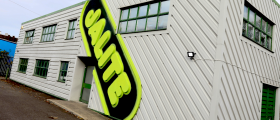
The JALITE Promise to you!
The JALITE Promise to you! For the team at JALITE, this year is synonymous with new beginnings, refreshing ourselves, and recommitting to the quality that underpins all that we do. After celebrating 40 years of fire safety at JALITE, we want to reaffirm the fundamentals that has made JALITE the global leader for photoluminescent fire safety products today. Moving forward, we want to regularly hear from you and use this as our foundation to improve and build on our services, to achieve our ultimate mission of providing you with great customer services. JALITE authorised distributors are guaranteed to receive the following: fast delivery and lead times, a UK customer services team, marketing materials, conformance to Standards, Class C+ luminance performance of photoluminescent material, and compliance to legislation. Read more about the JALITE guarantee below! JALITE your trusted source: Established in 1983, JALITE is a family-owned business, built on the innovation from our late director John Creak. John used his background in chemistry to perfect the photometric pigments to create the world leading JALITE AAA photoluminescent material, for fire safety signs and fire safety products. He worked to expand our global markets and international footprint, whilst eliciting the help of his twin brother Jim Creak who cultivated relationships with many of you in the UK. Jim is now a consultant of the business, using his technical expertise and quality assurance to educate the next generation of safety professionals. JALITE remains a British family-owned business, with Nicholas Creak as the CEO, and the management team of Hayley Bishop and Steve Perry who are committed to providing outstanding products and maintaining a high level of service for you all. JALITE fire safety signs are also Made in Britain, manufactured right on your doorstep, according to British Standards and legislation. We can therefore guarantee fast delivery and lead times, with 1 to 4 working days for all JALITE Standard fire safety signs, including our photoluminescent and white fire safety signs. JALITE Services: JALITE are a UK based customer services team, with decades worth of experience, especially regarding fire safety signs design Standards and regulations. This includes legislation changes and updates that are particularly pertinent to all Responsible Persons, such as the Fire Safety (England) Regulations 2022, for wayfinding signs. The JALITE team is equipped to give you technical support, helping you grow your business; allowing you to justify and specify JALITE photoluminescent fire safety signs. Marketing, literature and JALITE product pages are also available to you, to give you this vital technical information such as the introduction of new fire safety signs, whilst you’re on the go. Contact us now as an authorised distributor to get marketing materials emailed to you today! JALITE Commitment to Conformance: JALITE have been on the board of committees and associations for British and International Standards for many years. This has made us the industry leaders for the design of fire safety signs and products, at the forefront of setting standards of conformance for the industry. The standards are the blueprint for us, assuring quality and uniformity in all that we do. JALITE have always been devoted to in house research and development, sharing our outcomes with our authorised distributors, and other safety professionals such as architects and specifiers such as risk assessors. JALITE fire safety products conform to the following Standards: BS EN ISO 7010:2020 for Graphical Symbols- Safety Colours and Safety Signs- Registered Safety Signs BS 5499-4:2013 for Safety Signs, including for Safety Signs- Part 4: Code of Practice for Escape Route Signing. BS 5499-10:2014 for Safety Signs, including Fire Safety Signs- Part 10: Guidance for the Selection and use of Safety Signs and Fire Safety Notices. BS ISO 3864-1:2011 Graphical Symbols-Safety Colours and Safety Signs- Part 1: Design principles for Safety Signs and Safety Markings. BS ISO 3864-3:2012 Graphical Symbols- Safety Colours and Safety Signs- Part 3: Design Principles for Graphical Symbols for use in Safety Signs. BS ISO 3864-4:2011 Graphical Symbols- Safety Colours and Safety Signs- Part 4: Colormetric and Photometric Properties of Safety Sign Materials. BS ISO 16069:2017 Graphical Symbols. Safety Signs. Safety Way Guidance Systems (SWGS). BS ISO 17398:2004 Safety Colours and Safety Signs. Classification, Performance, and Durability of Safety Signs. DIN 67 510 Part 1:2020 Phosphorescent Pigments and Products - Measurement and Identification by the Manufacturer. Contact us today for more information on how you can conform to Standards! JALITE Photoluminescent Luminance Performance: The creation of JALITE AAA photoluminescence was a key milestone in the JALITE journey. John’s innovation set a new industry benchmark for performance, that was unmatched and decades ahead of the rest of the industry. JALITE AAA photoluminescent class C+ material, has always been 3 times the optical brightness since John created it. JALITE AAA photoluminescent products are always class C+ luminance performance as a minimum, both effective and the best performing in low-light or dark conditions. JALITE AAA photoluminescent material has a 30+ year shelf life and is available in both rigid and vinyl PVC. JALITE Compliance to Legislation: JALITE beginnings coincided with a timeline of disasters in the 1980s, with the Piper Alpha Oil Catastrophe that saw 167 lose their lives. These disasters emphasised the need for fire protection for people whilst at work. At the time, JALITE was already positioned within the industry, with our photoluminescent products already installed; primed and ready to be the solution as demand for fire safety signs increased. With tragedies like Grenfell, legislation rightfully developed to look at the intricacies involved in protecting people at home as well. JALITE is the solutions to compliance to legislation, and minimising risks of injury, harm, and death for occupants. JALITE fire safety signs comply to the following legislation: The Health and Safety (Safety Signs and Signals) Regulations 1996 The Regulatory Reform (Fire Safety) Order 2005 The Building Regulations 2010 The Fire Safety (England) Regulations 2022. Find out more: We are hopeful for the year ahead, ready to help you and work together to make this year the most successful one for us all! Contact us at sales@jalite.com or +44 (0)1268 242 300 for any support or further information you need.
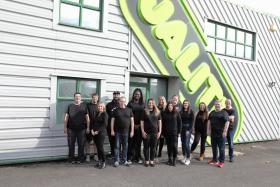
A New Chapter for JALITE Group
A New Chapter for JALITE Group With a new year ahead, we are embarking on a new journey at JALITE Group, allowing for a more seamless experience for our global community of authorised distributors. With a change of leadership in our sister company JALITE Asia, we have decided to offer our customers a means to premium customer services, technical support, and a centralised ordering service. We are committed to ensuring that our customers all over the world continue to receive the best services from JALITE Group. Farewell to Norris Wong, Director of JALITE Asia: Our new journey sees us bidding a heartfelt farewell to Norris Wong, after more than two decades as part of the JALITE family. Norris originally joined the JALITE Group in 2003, to advise us on the intricacies of marketing JALITE products in Hong Kong, and the Asia Pacific regions. As the role as part of JALITE Asia developed, Norris began building a network of contacts and authorised distributors in the region. JALITE Group extends our gratitude to Norris for her unwavering dedication and wish her the very best in all her future endeavours. JALITE Global Commitment: With the departure of Norris, we are excited to announce that JALITE PLC is now strategically positioned to directly serve our clients worldwide. This transition is designed to provide customer services, technical support, and a smooth experience for our valued customers wherever they are in the world. Important Contact Information Update for JALITE Asia Clients: All enquires and order for the Asia Pacific regions, including China, Hong Kong, Japan, Australia, and many other countries, will be handled by the JALITE team based in the UK. For any communication related to JALITE Asia, please ensure that you contact us exclusively through sales@jalite.com, asia@jalite.com, +44(0) 1268 242 300, and no longer through Norris Wong’s previous email address norris@jalite-asia.com. We appreciate your continued support, and we look forward to working with you as we embark on this new chapter in our global journey.
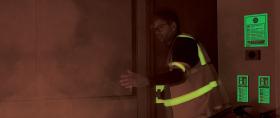
What is Photoluminescence
FREQUENTLY ASKED QUESTIONS What is photoluminescence? Photoluminescence is a special kind of phosphorescence. The energy needed to activate it is supplied by common light sources such as daylight, tungsten filament and fluorescent lights. Under sudden power loss situations, the material is conspicuous at some distance, providing an effective, bright contrast for text and graphical symbols and ensuring that safety messages are quickly recognised. This assists people to orientate themselves so that they can react effectively and evacuate efficiently. How do the materials work? JALITE photoluminescent materials contain purpose designed inorganic phosphor compounds that are energised in seconds by the ultra violet and blue light wavelength energy that is present in nearly all light sources. This high-energy source is converted into a lower energy source of light. The lower energy light source is yellow-green, the colour most readily perceived by the human eye and as specified by safety signs standards. JALITE photoluminescent materials are non-radioactive and non-toxic and provide a strong light source. They are also self-extinguishing, so they carry on working when they are most needed. How is the material used? JALITE photoluminescent materials can be used for many safety applications, including: Life saving equipment identification Fire safety signs Health and safety signs Escape route marking Low location illumination Directional route marking tape The materials have already been successfully applied in the following sectors: Government Hospitals Chemicals Transport Power Industrial Navy Leisure Marine Education Financial Retail The materials are also suitable for use in a wide range of commercial applications. Why Signs? When an emergency occurs, the time between the lights going out and the emergency lights coming on, coupled with the sound of the fire alarm is the time when panic and confusion can set in. Photoluminescent safety signs emit a strong light source under sudden power loss situations. This helps people to orientate themselves to ensure that they can evacuate efficiently and effectively Will Photoluminescence replace traditional lighting? JALITE photoluminescent materials were originally designed to complement existing emergency lighting systems but continuous improvements in luminance performance mean that in certain circumstances high quality photoluminescent products can replace emergency lighting. They can be sited at waist or skirting level so they can still function if the ceiling lights become obscured by smoke. Similarly, life saving appliances and fire fighting equipment become more visible and are easily located in an emergency. Some emergency lighting can take up to 15 seconds to activate. In these instances, photoluminescence can be a lifesaver. Are signs required above extinguishers? The requirement for any safety sign is determined by the formal risk assessment. In respect to fire fighting equipment including fire alarms the test is quite simple. Can they be identified and located quickly and effectively in an emergency? Do all the building occupants know the exact location of this vital equipment? If the answer is likely to be no to any extent then the Health and Safety (Safety Signs & Signals) Regulations requires the use of appropriate markings or signs. The most important parts of any risk assessment is objective data. The only data we have on this subject is that from Essex Fire & Rescue who have states that a large percentage of employees do not know the location of their fire extinguishers. If this is the case there is clear evidence that they need to be appropriately signed.

Wayfinding: Why does it matter?
Wayfinding: Why does it matter? The last few years has seen significant ongoing efforts from the UK government to improve fire safety after the tragedy of Grenfell. These efforts have come in the form of The Fire Safety (England) Regulations 2022, amendments to the Approved Document B, as well as the new fire safety regulations ‘Phase 3’ that came into effect from 1st October. The major steps forward in legislation and guidance for the Fire Safety Industry has rightly shown where our industry needs to improve, including bringing to light the areas of fire safety that are often neglected. One area that is often neglected and pertinent to JALITE is wayfinding signage. Since our beginnings 40 years ago this year, JALITE through in-house research and development, and leadership on committees and associations, have set Industry Standards for fire safety signage. This has made JALITE the go to source for technical information, for our valued distributors and beyond, especially in reference to the new fire safety legislation and guidance. Since the amendments and introduction of legislation and guidance, JALITE have naturally been inundated with enquiries and questions particularly about wayfinding signage. Below, we are going to provide some insight into the following: What is wayfinding signage? Why is wayfinding signage needed? What wayfinding means for the Responsible Person? What is Wayfinding Signage: Wayfinding signage helps visitors to the building or setting, navigate unfamiliar environments providing visual cues, signage, and other navigational aids. In the context of a building or a facility, wayfinding encompasses various design considerations and elements that guide people from one location to another, including to a place of safety. With reference to The Fire Safety (England) Regulations 2022, and Approved Document B, wayfinding signage pertains to helping fire and rescue services navigate unfamiliar environments such as in blocks of flats and high rise residential buildings. Why is Wayfinding Signage needed: The Grenfell Tower Inquiry saw subsequent recommendations to help fire and rescue services orientate themselves, within blocks of flats during an emergency. The Fire Safety (England) Regulations 2022, and the Approved Document B reference, that wayfinding signage including floor and flat identification signs, be located on every landing of a protected stairway and corridor/lobby. This is of course dependent on the process of formal fire risk assessment. As part of these suggestions, the text and arrows of the floor and flat identifications signs are to be visible in low level lighting such as in fire or power loss situations. JALITE AAA market leading photoluminescent fire safety signage is your solution. This coupled with the Premises Information Boxes minimises the risk of injury, harm or worse, by allowing fire and rescue personnel to efficiently progress through the building, enhancing the life safety for themselves and others during an emergency evacuation. What the Wayfinding means for Responsible Persons At JALITE we have always taken a full approach to guidance and recommendations. We focus on the intricacies, using British and International Standards for fire safety signage to inform our technical information, and ensure that we protect people and property to good practice; putting quality at the heart of all we do. There is always more that Responsible Persons and Appointed Persons can do to follow recommendations and guidance to prove competence, with this being recorded consistently. JALITE photoluminescent products are your trusted solution for wayfinding; providing safety way guidance system components i.e., signage, plans, low location lighting etc. to fulfil the following key aspects of wayfinding: Signing: plays a vital role in wayfinding and encompasses providing clear and visible information. This includes directional signs, room labels, floor directories, arrows, symbols, and other visual cues that guide individuals toward their desired destinations. Pathfinding: involves designing logical and intuitive routes within a building to help people navigate efficiently. This includes establishing clear pathways, minimising dead ends, and optimising the arrangement of spaces and circulation areas to support smooth movement. Landmarks and visibility: fire safety plans as part of wayfinding, benefits from the presence of distinct landmarks or points of reference that serve as visual anchors. These landmarks can be unique architectural features, artwork, or prominent objects that help individuals orient themselves and understand their position within the environment. Lighting and visibility: adequate lighting and visibility are crucial for effective wayfinding. Well-lit spaces, illuminated signage, and visibility of paths and intersections contribute to a clear understanding of the environment and aid in wayfinding. Colour and visual differentiation: the use of colour and visual differentiation as part of fire alarm zone plans assists in distinguishing different areas, zones, or levels within a building. Colour-coded signage, floor patterns, or distinct visual elements can help individuals identify and remember specific routes or areas. Digital wayfinding: with advancements in technology, and requirements from Business Information Modelling (BIM), digital wayfinding systems have become increasingly popular. These systems employ interactive maps, digital displays, mobile applications, and augmented reality to provide real-time navigation guidance, updates, and customised routes. JALITE understand how daunting these amendments and updates can be for all types of Responsible Persons within the Industry. We are always at hand via our UK customer Services team to help you with technical information, to help you grow your business and ultimately keep occupants safe. JALITE are your trusted source for quality information and products. Email us at sales@jalite.com or call us at +44 (0) 1268 242 300 if you need more information.

CCTV Signs for Business
CCTV Signs for Business In an age where data privacy is paramount, businesses that employ Closed-Circuit Television (CCTV) systems need to tread carefully to ensure compliance with the General Data Protection Regulation (GDPR). The use of CCTV has become ubiquitous, enhancing security and enabling monitoring for various purposes and because of this, for data protection purposes, the Information Commissioner’s Office (ICO) will need to know your reasons for using CCTV. Why Use GDPR CCTV Signs? Transparency: GDPR mandates that individuals should be aware when they are being monitored. Placing visible CCTV signs informs people about the presence of surveillance. Legal Compliance: Failure to comply with GDPR can lead to hefty fines. By using compliant CCTV signs, you demonstrate your commitment to following the law. Deterrence: Visible signs act as a deterrent to potential wrongdoers, enhancing security. When people know they are being watched, they are less likely to engage in malicious activities. Placement of GDPR CCTV Signs Entry Points: Install signs at all entrances to your premises, including both public and restricted areas. Key Surveillance Areas: Position signs near the most monitored areas within your establishment. This includes customer service desks, cash registers, and outdoor spaces. Employee Areas: If your CCTV system also covers employee workspaces, ensure there are signs in these areas to inform your staff. Some points to check to see if your signs are complicit with GDPR. Signage should be clearly visible and easy to read. If it’s not obvious who is operating the CCTV, details of the organisation should be shown as well as the reason CCTV is in use. Who to contact if there are any queries, preferably with a method of contacting them (ie phone or email). For more information on GDPR visit: https://www.gov.uk/data-protection-your-business/using-cctv and for information on the Information Commissioner’s Office (ICO) visit: https://ico.org.uk/ Security Signs In addition to CCTV signs, businesses often employ various other security signs to enhance safety, deter potential threats, and maintain order within their premises. Let's explore some of these signs: Guard Dog Signs: These signs indicate the presence of guard dogs on the premises. They serve both as a deterrent and a warning. The signs should clearly depict a dog symbol from BS ISO 7010 and can also show "Warning Guard Dogs" message. Just like CCTV signs, the visibility and location of these signs are critical to their effectiveness. Barbed Wire Signs: These signs notify individuals of the presence of barbed wire or other security measures such as razor wire. They should convey the message clearly and can feature symbol from BS ISO 7010 or symbol and text. These signs are essential in maintaining the safety of your property while avoiding accidents and injuries. No Photography Signs: For businesses that need to protect sensitive information or proprietary processes, "No Photography" signs restrict individuals from taking photographs or videos within a designated area. Effective signs include a camera symbol from BS ISO 7010 with a clear text message such as "No Photography." No Mobile Phones Signs: In areas where mobile phones can interfere with equipment or pose safety risks (such as in hospitals or near fuel stations), "No Mobile Phones" signs are essential. They communicate the prohibition of mobile phone usage. No Weapons Signs: These signs are often required in places like government buildings, schools, airports, or private properties where firearms and other weapons are not allowed. They can feature symbol from BS ISO 7010 and text, clearly indicating that weapons, incendiary devices or explosives are prohibited on the premises. Restricted Area Authorized Personnel Only Signs: These signs indicate areas that are off-limits to unauthorized individuals. They are crucial for maintaining security in facilities with sensitive information, machinery, or equipment that should not be accessible to the general public. Using security signs in your business is not just a legal requirement; it's a step towards fostering trust and transparency with your customers, employees, and the public. When done correctly, it enhances security while respecting the privacy of individuals. Your business can strike a harmonious balance between surveillance, security and data protection in a GDPR-compliant manner. In addition to CCTV signs, other security signs play crucial roles in maintaining safety, security, and order within your premises. Careful design, placement, and adherence to legal requirements are key to maximizing the effectiveness of these security signs.

Celebrating 40 Years of Safety
The Journey of JALITE PLC In the ever-evolving landscape of life safety, one name stands out as a beacon of trust and reliability - JALITE PLC. As we celebrate an impressive 40-year journey marked by a steadfast commitment to safety and innovation, JALITE has solidified its position as the go-to supplier for photoluminescent signs. Let's reflect on this remarkable journey and discover why JALITE is your preferred partner in safety. The Inception of Excellence Our story began with a commitment to excellence and safety innovation. Founded in 1971 as part of the Swiss company Decofim S.A., JALITE quickly gained recognition for our dedication to enhancing safety through harnessing and developing photoluminescent technology. The Birth of JALITE PLC in 1983 The rise of JALITE coincided with a clear timeline of tragedies in the 1980s that shaped the culture of fire safety whilst at work, stressing the need for photoluminescent products as a secondary source of emergency lighting. Unfortunately, the incidents repeatedly occurred within offshore environments, such as the Piper Alpha oil rig catastrophe, since named the world’s worst offshore disaster, as 167 men lost their lives whilst at work. The disasters rightly initiated discussions about health and safety in our global communities; with guidance for mitigating risks of injury, harm, or death for people whilst at work and beyond. In essence the tragedies highlighted the need for reformed health and safety requirements and guidance, including signing systems and Safety Way Guidance Systems. JALITE was at hand to accommodate this need for radical change within health and safety. John Creak's Vision and Dedication In 1999, John Creak became the proud owner of JALITE PLC and took on the role of CEO. His background in chemistry, business, and marketing uniquely positioned him to lead the company into the international arena. John was not only an adept leader but also a hands-on innovator. He worked tirelessly in the lab, perfecting photometric pigments and materials used in JALITE products including our fire safety signs and other low location lighting systems. John pushed the boundaries of what photoluminescent safety technology could achieve; the result was the creation of JALITE AAA photoluminescent market leading material. JALITE AAA the pioneer of new industry Standard The creation of JALITE AAA photoluminescence was a key milestone in our journey. John’s innovation set a new industry benchmark for performance, that was unmatched and decades ahead of the rest of the industry. JALITE AAA photoluminescent class C+ material, has always been 3 times the optical brightness of other photoluminescent material since John created it. JALITE AAA photoluminescent products are always class C+ minimum, both effective and the best performing in low-light or dark conditions. The pursuit of excellence and quality in safety became a hallmark of the JALITE mission. Setting Safety Standards John's dedication to safety extended beyond just the laboratory and JALITE. He actively engaged in setting safety requirements through organisations like BSI (British Standards Institution) and PSPA (Photoluminescent Safety Products Association), further solidifying our role as an Industry leader in safety and innovation. Jim Creak: A Partner in Safety John Creak made a strategic decision to enlist the support of his identical twin brother, Jim Creak, in the journey to elevate JALITE success. Many of you in the UK have had the privilege of a personal connection with Jim. With a rich background in sales and marketing, Jim skilfully cultivated relationships, elevating JALITE brands’ presence across the UK. His regular provision of technical expertise and quality assurances for JALITE products ensured customer satisfaction, allowing John the flexibility to explore global markets and expand our international footprint while providing invaluable strategic direction and innovation. Jim's unwavering dedication to the company closely paralleled his brother's commitment to safety and cutting-edge advancements. In 2022, Jim Creak left for a well-deserved retirement. However, his connection to the company and his passion for safety never waned. Jim now supports the new management through his consultancy work, sharing his wealth of knowledge and experience with the next generation of safety professionals. A Family Legacy Tragically, John Creak passed away in 2021, leaving behind a remarkable legacy of dedication to safety. His vision and passion for JALITE was passed on to his family, and with the support of the dedicated staff, together with Hayley Bishop and Steve Perry, Nicholas Creak has assumed the role of CEO. Nicholas is committed to continuing his father's legacy by providing outstanding products, maintaining a high level of service, and upholding the tradition of producing quality safety solutions in the UK. Together we will ensure that JALITE legacy continues to grow, lighting the way for a safer more secure world. Conclusion As we celebrate 40 years of safety, our journey is a testament to the power of innovation, unwavering dedication, and a commitment to setting the highest safety standards. From our founding in 1983 to our position as a global leader today, JALITE has consistently illuminated the path to safety, saving lives all around the world. When you choose JALITE as your partner in safety, you're choosing four decades of excellence, innovation, and unwavering dedication. Trust in JALITE – your beacon of safety.
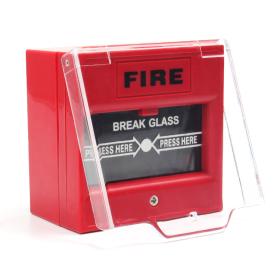
Why do fire alarm call points need covers
Why do fire alarm call points need covers JALITE fire safety signs are integral to mitigating risks of injury, harm, or death to occupants, as well as to public and private property. This is true in all lighting conditions, as JALITE signs reinforce safety messages to occupants in all lighting conditions, including in smoke filled areas during an emergency. JALITE fire safety signs are installed alongside life saving equipment such as fire alarm call points to help occupants locate this vital equipment. What are Fire Alarm Call Points?: Fire alarm call points, also knowns as manual call points, are key to allowing occupants to evacuate during an emergency. This firefighting equipment are installed in many public spaces, including shops, hotels restaurants, offices, and other public spaces to allow the public and staff members to trigger the overall fire alarm system of a building. The easy access to fire alarm call points, is the very thing that pose a risk to other occupants with costs to businesses and time for fire and rescue services adding to further disruption. With this in mind, BS 5839-1 was the Standard introduced to bring significant change, with guidance that states call points should be fitted with a protective cover to reduce false alarms. The revision of BS 5839-1 specifically states that "All MCPs should be fitted with a protective cover, which is moved to gain access to the frangible elements”. Whilst the standard does not specifically refer to existing call points, retro fits are available for most industry standard call points. This new change should help prevent accidental activation from impact and should force users of the fire alarm system to lift the cover before activation, thereby adding an extra action to the process of pressing the alarm. The solution to the risk: We want to protect firefighting equipment such as the fire alarm call points, but we want to equally to ensure that this vital equipment can be easily and quickly accessed when needed most. When a fire breaks out, the last thing we want is confusion from a visitor or member of the public, who is confused about how to access the fire alarm call point. This ultimately causes delay, and therefore a possible risk to people and property. JALITE photoluminescent ‘lift cover to operate fire alarm’, fire safety signs are your solution for potential delay, and mitigating risks of injury, harm, or worst-case death to building occupants. JALITE photoluminescent ‘lift cover to operate fire alarm’ signals to occupants how they can access the fire alarm call point, as well as how to activate the vital equipment. Our JALITE photoluminescent ‘lift cover to operate fire alarm’ fire safety signs are characterised by firefighting red colours and square shape, as per the Standard BS ISO 3864- 1:2011. JALITE photoluminescent ‘lift cover to operate fire alarm’ fire safety signs are also designed according to BS EN ISO 7010:2020; the fire alarm call point graphical symbol of the finger, and the flame determinant. JALITE photoluminescent ‘lift cover to operate fire alarm’ fire safety signs, are available in two sizes as standard including (D) 150 x 200mm, and (Y) 100 x 150mm. Code: 6131D Size: 150 x 200mm Code: 6131Y Size: 100 x 150mm Have assurance that JALITE photoluminescent fire safety signs, are your solution to keeping occupants safe, and able to evacuate from the building even in conditions of low visibility.
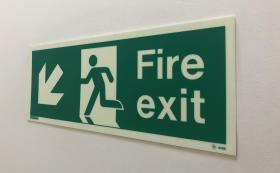
Guidance for Signs & Notices
Fire Safety Signs and Notices Legislation requires the Duty Holder (in a workplace, normally the employer) to carry out a formal risk assessment to determine the need for fire safety signs. The requirements for the characteristics of fire safety signs and notices are encompassed within the Health and Safety (Safety Signs and Signals) Regulations 1996 and the guidance in relevant British Standards. Fire Exit and Escape Route Signs The legislation requires all duty holders to ensure that the means of escape is effectively located and the route to a place of relative safety be clearly identified. Where the building manager, facilities manager/duty holder requires specific guidance to achieve this, a competent person should be consulted. Guidance on the application and siting of means of escape signs is given in BS 5499 Part 4. The following key elements of escape route signing will influence effective evacuation: Illumination: All escape route signs should be adequately illuminated to ensure they are conspicuous and legible within the environment. All escape route signs should be visible under power loss conditions. It may be appropriate in some premises that a maintained light source is provided or the same objective can be achieved with a photoluminescent escape route sign. Sign Height (Graphical Symbol Height): All escape route signs are required to be observed from a distance, this distance alongside the illumination will determine the observation distance of the escape route sign. Full guidance can be found in BS 5499 Part 4. However, a simple guide for an externally illuminated sign at 100 lux will give an observation distance of 22 metres for a sign height of 130mm (z=170). Direction of Egress and Escape: From any point within a building it is important that people have immediate sight of an escape route. If they do not or doubt may exist, an escape route sign or series of signs is likely to be necessary. The use of directional arrows within escape route signs are standardised to ensure that egress is intuitive and efficient. Priority for escape route signs should be given to the shortest route to safety. Progress forward from here (indicating direction of travel) Progress forward and through from here; when sign is sited above a door (indicating direction of travel) Progress forward and up from here (indicating change of level) Progress to the right from here (indicating direction of travel) Progress down from here (indicating change of level) Progress to the left from here (indicating direction of travel) Progress down to the right (indicating change of level) Progress down to the left (indicating change of level) Progress up to the right (indicating change of level) Progress forward and across to the right from here when suspended within an open area Progress to the left from here (indicating direction of travel) Progress forward and across to the left from here when suspended within an open area Figure 1 - BS5499-4 Directional meaning of escape route sign(s) The series of escape route signs within the designated means of escape should be positioned to progress the person to a place of safety. An escape route sign should be positioned at every change of direction, every change of level and at any decision point within the escape route. Mounting Height: Escape route signs should be sited at 2.0m from the floor when positioned above doors or where suspended from the ceiling and at 1.7m from the floor when positioned on walls. As people progress along an escape route, the next escape route sign within the series should be in a predictable position following on from its predecessor in the series of escape route signs. Other Fire Safety Signs and Notices Legislation requires that all people are provided with relevant fire safety information such as the location and operation of panic hardware, door opening devices and emergency security override equipment. Legislation requires appropriate identification and location to all building occupants to ensure effective evacuation. The same applies for people with special needs who may require assistance to locate designated safe areas as part of their Personal Emergency Evacuation Plan (PEEP). All life safety equipment and designated areas should be appropriately signed. Figure 2 - Typical emergency evacuation area/equipment sign(s) A key element of effective evacuation is the detection of fire and manual activation of alarm call points. Legislation requires the duty holder to ensure building occupants can identify and locate this equipment. It is also a requirement that building occupants know the procedure to adopt in the event of fire and alarm activation, the display of appropriate notices, in clear and precise format is recommended to support good fire safety management and formal training. Figure - 3 - Fire alarm call point sign, fire action notice(s) & Fire extinguisher identification notice. Legislation requires that, where necessary, fire fighting equipment be indicated by signs. Figure 4 - BS EN ISO 7010 Fire fighting equipment sign(s) & Fire safety notice(s) The Duty Holder has an obligation to provide people with information that is essential for their protection. The provision of this information is recommended by government guidance on both building regulations and fire safety legislation. Figure 5 - Mandatory fire safety instruction notice(s) Further signs that may be required depending on the type and use of the premises. Activity, process or practice may require the identification and location of hazards that particularly affect the risk matrix. It may also be prudent that an indication of risk control is displayed where this measure is critical to management of risk. This process will complement the formal risk assessment and the identified significant findings. The measures will form part of the fire safety manual and risk reduction management. Figure 6 - Management of risk - Risk/prohibitive action combination sign(s) There are important changes that now require duty holders to audit and review the fire safety signs within their buildings. This audit and review should ensure conformance to BS EN ISO 7010 for graphical symbols that have excellent comprehension credentials. Fire Safety signs should be reviewed periodically to ensure they continue to support the fire safety strategy for the premises. When purchasing the supply and installation of fire safety signs the user should specify that the products and the position and location of the signs and notices comply with ISO 7010 and BS 5499 part 4 and BS 5499 part 10.
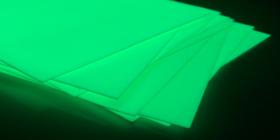
Photoluminescent Material
JALITE Photoluminescent Material JALITE have dedicated 40 years to in house research and development, to create our market leading photoluminescent JALITE AAA material. We have worked with the world’s leading phosphor technology holders, to identify unique pigments for this material. JALITE AAA material is exclusively used across our 4,000 products including our renowned fire safety signs and non-electrical low location lighting; installed worldwide for life and fire safety. JALITE AAA products are installed across the worlds high rise residential buildings, tall buildings, commercial and industrial facilities, trains, aeroplanes, oil rigs, and ships. But what is photoluminescent material? Why do responsible persons consider this over other material for their safety products? How does photoluminescent technology mitigate risks of injury, harm, and death for occupants? What is photoluminescence? Photoluminescent material is phosphorus material that absorbs light (either daylight or artificial) within the surroundings, which then charges this material. The phosphors then emit this light out to increase visibility for those within proximity to the fire safety signs and products. The luminance performance and class of photoluminescent material is dependent on: Time taken to charge the material to minimum emission of light (lux) Time taken to lose the charge of the material The level of millicandela (output) that can be reached. JALITE AAA photoluminescent material boasts the best luminance performance on the market, with third party accreditation for testing proving that minimal lighting provides the longest light output. JALITE AAA photoluminescent material is categorised as C+ class material, with options for material that exceeds this for aircrafts and spacecrafts that is D + class upwards. Rest assured that all JALITE AAA material conforms to requirements of DIN 67 510 part 1: 2020 for the measurement of phosphorescent pigments and products. How does photoluminescent work to save lives? JALITE AAA photoluminescent fire safety signs save lives by paving the way to safety in all lighting conditions. In an emergency evacuation where smoke has filled the area or there is loss of power, JALITE photoluminescent fire safety signs are proven to help occupants escape, by increasing the visibility of the escape routes during times of emergency. This has been the case since the installation of JALITE products in tall buildings since the tragic events of 9/11, as well as in many high- rise residential buildings in recent years since Grenfell. In areas of infrequent light such as plant rooms on site, JALITE AAA photoluminescent fire safety products and signs still can be activated, achieving high optical brightness for safe egress. All JALITE photoluminescent fire safety signs further protect the life safety of occupants, as all signage is designed to conform to fire safety sign Standards. Our fire safety signs are designed to BS EN ISO 7010:2020 for graphical symbols that allow for reinforced standardised, and therefore universal safety messages, for worldwide comprehension. Why choose photoluminescent? JALITE AAA photoluminescent fire safety signs, have a 30+ year shelf life, a trusted source of fire safety equipment for occupants. Some of JALITE AAA photoluminescent products are still installed paving the way to safety even after two or more decades. JALITE photoluminescent fire safety products and signs are reliable, taking only a fraction of light to charge and activate the material. This is why JALITE AAA photoluminescent products are often installed alongside the buildings’ standard emergency electrical lighting available. JALITE photoluminescent fire safety signs and products, if maintained are often referred to as the failsafe option for getting evacuees out to a place of safety. Our fire safety products provide comparably competitive fire safety options, without you having to compromise on quality. JALITE AAA photoluminescent material is often considered the more sustainable option for improving visibility in darkness and smoke for evacuees. Our material can be regarded as the environmentally friendly and sustainable option, reducing your overall carbon footprint. JALITE AAA photoluminescent material is used to manufacture both rigid and vinyl fire safety signs, with both materials available for purchase in various sizes, either in standard signs or in bespoke signs. JALITE AAA photoluminescent material is: Weather resistant Durable Self-extinguishing Flexible and adaptable Matte, non-glare surface. If you would like more information on JALITE AAA photoluminescent material, please call +44 (0) 1268242300 or email sales@jalite.com.
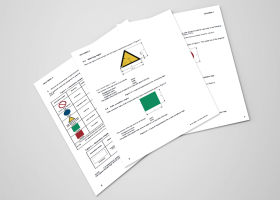
What are safety colours and shapes
What are safety colours and shapes Safety signs use various safety colours and shapes to convey important information and warnings. The colour and shape of a safety sign are designed to quickly and effectively communicate the message to individuals in different situations. Here are some common safety sign colours and shapes: Geometric shapes, safety colours and contrast colours for safety signs Geometric shape Meaning Safety colour Contrast colour to the safety colour Graphical symbol colour Examples of use Circle with diagonal bar Prohibition Red Whitea Black — No smoking — Not drinking water — Do not touch Circle Mandatory action Blue Whitea Whitea — Wear eye protection — Wear protective clothing — Wash your hands Equilateral triangle with radiused outer corners Warning Yellow Black Black — Warning; Hot surface — Warning; Biological hazard — Warning; Electricity Square Safe condition Green Whitea Whitea — First aid — Emergency exit — Evacuation assembly point Square Fire safety Red Whitea Whitea — Fire alarm call point — Collection of fire fighting equipment — Fire extinguisher a = The colour white includes the colour for phosphorescent material under daylight conditions with properties as defined in ISO 3864-4. Prohibition Signs Prohibition signs are safety sign used to communicate prohibited action or behaviour in various settings. These signs typically feature a red circle with a diagonal line crossing out a symbol representing the prohibited action. The signs in ISO 7010 are designed to be easily recognizable and understood, regardless of language barriers. Some common examples of prohibition signs include: No Smoking: This sign indicates that smoking is not allowed in the designated area. No thoroughfare: This sign prohibits people from entering a specific pathway or zone, usually on roads or construction sites. No Cameras: This sign may be used in places where photography or video recording is not permitted. No Food or Drink: This sign is commonly found in areas where consuming food or beverages is not allowed, such as museums or certain sections of public transportation. It's important to pay attention to prohibition signs as they help maintain a safe environment in various public and private spaces. Mandatory Signs Mandatory fire signs are a type of safety signage that indicates specific actions or behaviors that are required to be followed. These signs are typically placed in buildings, workplaces, and public areas to ensure that people know what to do to protect themselves and others. Here are some common examples of mandatory safety signs: Fire Door Keep Shut: These signs remind people to keep fire doors closed at all times. Fire doors are crucial in preventing the spread of fire and smoke, and they should not be propped open. Keep Clear: Placed near firefighting equipment, doors and machinery to ensure that these areas are not obstructed or blocked. Wear Head Protection: This sign indicates that a hard hat must be worn to protect the head from falling objects or potential head injuries. Wear eye protection: This sign indicates that safety glasses or goggles must be worn to protect the eyes from flying debris, chemical splashes, or other hazards. Familiarising yourself and understanding the meanings of mandatory signs will they help maintain a safe environment. Warning Signs Warning safety signs are designed to alert people to potential hazards or dangers in a particular area. These signs are typically displayed in workplaces, public spaces, construction sites, and various other locations to promote safety and prevent accidents. Warning signs are characterized by their triangular shape, with a black pictogram or symbol on a yellow background. Here are some common examples of warning safety signs: Warning; Electricity: Indicates the presence of electrical equipment or areas with high voltage, warning people to stay away or take necessary safety measures. Warning; Slippery surface: This sign alerts people to the possibility of a slippery floor or surface, cautioning them to walk carefully to avoid slipping. Warning; Corrosive substance: This sign indicates the presence of dangerous chemicals or substances and reminds individuals to handle them with care. Warning; Falling objects: This sign is commonly used in construction zones or areas where objects may fall from above, alerting people to the danger. Warning safety signs play a crucial role in ensuring the safety of individuals and should always be heeded to prevent accidents and injuries. It's essential to familiarize yourself with these signs and their meanings to stay safe in different environments. Safe Condition Signs Safe condition signs are a type of safety signage used to indicate the location of safety-related equipment or areas within a facility. These signs have green backgrounds with white symbols. Safe condition signs are designed to provide information and direction to ensure the safety of individuals in the area. Here are some common examples of safe condition signs: First Aid Sign: These signs identify the location of first aid stations or kits. They often feature the white cross symbol on a green background. Emergency Eyewash Station Sign: This sign marks the location of emergency eyewash stations in case of chemical spills or exposure. Emergency Assembly Point Signs: These signs indicate where individuals should gather in case of an emergency evacuation. Emergency AED Signs: These signs highlight the location of automated external defibrillators (AED) and can be found in public places including shopping centres, restaurants, public transport, and many other location. Remember that the design and symbols used in safe condition signs may vary depending on the country and region, as there might be slight differences in safety sign standards. However, the core purpose of these signs remains the same - to promote safety awareness and guide people to the appropriate safety resources in the event of an emergency. Fire safety signs Fire safety signs are visual aids used to convey important information about fire safety measures, hazards, and escape routes in buildings and public spaces. These signs play a crucial role in ensuring the safety of occupants during emergencies and guiding them to appropriate actions. Here are some common fire safety signs: Fire Extinguisher Sign: Indicates the location of fire extinguishers. Usually depicted by a white symbol of a fire extinguisher on a red rectangular background. Fire Blanket Sign: Indicates the location of fire blankets. Displayed as a white symbol of a Human figure holding a fire blanket, flame determinant on a red background. Fire Hose Reel Sign: Identifies the location of fire hose reels. Usually depicted by a white symbol of a hose reel on a red rectangular background. Fire Alarm Sign: Informs people about the location of fire alarms. displayed as a white hand with one finger extended, dot in square symbol, flame determinant on a red background. These signs are standardized and follow specific design guidelines from ISO 3864-3 & ISO 7010 to ensure easy recognition and understanding, even in stressful situations. They are essential in helping people quickly identify fire safety equipment, and important safety measures during an emergency.
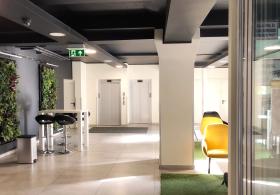
Viewing distance of a safety sign
Expected Viewing distance of JALITE AAA Exit signs Safety signs are designed to convey important information and warnings to individuals in various environments. The viewing distance for safety signs depends on several factors, including the size of the sign, the graphical symbol elements and their size within the shape of the safety sign, and the environment in which the sign is placed. The expected viewing distance of a safety sign is described according to the Z factor. The Z factor is the ratio of the viewing distance divided by the sign height (graphical symbol height plus geometric shape according to ISO 7010 image) - Direct line of sight. Viewing distance by sign size (millimeters) 100 Lux vertical illumination (meters) (Z factor ISO 3864-1 = 170) 5 Lux vertical illumination (meters) (Z factor ISO 3864-1 = 170) 200 x 400 34 19 250 x 500 42.5 23.75 300 x 600 51 28.5 400 x 800 68 38 Click here for more information on BS ISO 3864-1:2011 Click here for more information on BS EN ISO 7010:2020
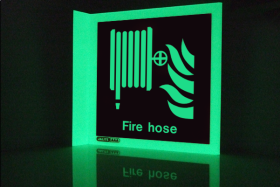
Different Sign Types Available
Different Sign Types Available Safety signs are essential tools for creating a safer environment, promoting compliance with safety regulations, and effectively communicating critical information to individuals in various settings, JALITE offer a range of different sign types, in this section we will show examples and viewing areas for different types of signs e.g. Wall mounted signs, Panoramic signs, Double-sided wall mounted signs and Double-sided hanging signs. Wall Mounted Safety Signs Wall mounted signs can be seen clearly when approaching them from straight on offering a viewing area of 90° Panoramic Safety Signs Panoramic wall mounted signs offer a wide viewing area of that can be viewed in most directions when approaching them, offering 180° viewing area. Double-sided Safety Signs Double-sided wall mounted signs aim is to offer a wide viewing radius, ideal for corridors where the sign can be viewed when approaching from two directions. Double-sided Hanging Safety Signs Double-sided hanging signs aim is to offer a wide viewing radius in a large area, when approaching from two directions.

Health and Safety Sign Association
Health and Safety Sign Association The Heath & Safety Sign Association - HSSA was formed with the purpose of educating the nation on signage legislation, in order to improve health and safety for everyone. With members from some of the largest signage companies in the country, the HSSA keep up to date with any legislative changes that may happen within the UK. HSSA has two basic aims as follows create greater safety through the proper use of safety and other statutory signs. develop and maintain industry standards and act as an industry voice to those formulating standards and legislation internationally. Not only do the HSSA aim to keep you clued up on the legislative side of signage, they also ensure that all of their own signage conforms to the required standards. This means you can rest assured, knowing your signage will be compliant. www.hssa.co.uk
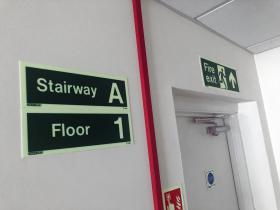
Stairway and Floor numbering signage
Stairway and Floor numbering signage To compliment egress path marking on walls, floors and steps, floor numbering, stair case identification and orientation signs are essential for smooth ordered and planned evacuation. It is just common sense to make it perfectly clear where people are and where they need to go in an emergency. If you are looking for a complete plan of orientation and stairway management and require a personalised service including instruction for cross over floors and escap path instruction do not hesitate to contact us at sales@jalite.com your problem will be solved ! For more up-to-date info Click here
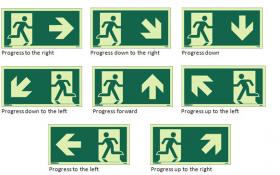
JALITE Safety Sign Audit and Review
Fire Safety Sign Audit & Review To provide a visual inspection (up to an hour), whilst on site, of the fire safety signs within an agreed scope that can include Means of escape route identification signs Emergency door opening devices signs Mandatory fire door notices Fire action notices Fire fighting equipment location and type identification Specific hazard identification signs (limitation to be agreed with client, such as mind the step hazards on means of escape route, main electrical intake) Specific prohibition notices (limitation to be agreed with client, such as do not use the lift in event of fire) Assembly point location signs The Audit would look at the provision of fire safety signs expected to be in place for compliance with Legislation and Regulations. This would include the existing signs and making an observation as to whether additional signs would be required. In order to meet the requirements of legislation best practice advice would be given based on the relevant National and/or International Standards relating to the types of signs and their design. The Audit would be followed up with a short report which can include; Reference to the particular piece(s) of legislation needed to comply with Relevant Standard/Code of Practice recommendations are based on without going into specifics whether or not their signs will meet current regulations. This could be split into specific types of signs, whether additional signs would be required, whether some existing signs could be removed, including internally illuminated signs to reduce on-going energy consumption, whether or not a full fire safety signs survey would be recommended.
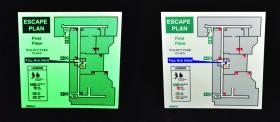
Stay Safe in a Tall Building
Stay Safe Know the Plan - Tall Building In July of 2009, a fire broke out on the 9th floor of a 14-storey residency by the south of London. The fire quickly spread to the 11th floor where it took the lives of six residents. Weeks before the fire one of the victims had asked why there were no diagrams in the building to show where the emergency exits were. Those who perished in the fire had remained in their flat, but those who did escape the blaze described the scene as being “chaotic” and said that the maze-like layout of the building made evacuation extremely difficult. Why weren’t evacuation plans installed within the large, 14-storey building? An inquiry into the answer of that question began on January 14, 2013. The National Fire Protection Agency (NFPA) released an article on their site that describes how to stay safe if you are in a tall building. The number one tip? Know the plan. The article says, “Make sure that you're familiar with your building's evacuation plan, which should illustrate what residents are supposed to do in the event of an emergency.” These all important diagrams were unfortunately absent from too many tragedies. Ensure that the occupants and staff in your facility stay safe and “know the plan.” Contact JALITE today to find out how you can install photoluminescent evacuation plans to identify the way out in both a light and dark emergency. With JALITE evacuation plans you can rest assured that - When the lights go out, ours go on™.
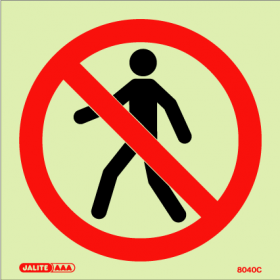
International Safety Signs and Symbols
International Safety Signs and Symbols JALITE since 1981 has been involved in developing and applying Standards to photoluminescent safety products a useful reference list of Standards used are as follows: Specification Properties and test methods ISO BS 17398 Safety colours and safety signs -- Classification, performance and durability of safety signs ISO BS 3864-4 Graphical symbols -- Safety colours and safety signs -- Part 4: Colorimetric and photometric properties of safety sign materials ISO 9186-1 Graphical symbols -- Test methods -- Part 1: Methods for testing comprehensibility ISO 9186- 2 Graphical symbols -- Test methods -- Part 2: Method for testing perceptual quality DIN 67510-1 Photoluminescent pigments and products - Part 1 Measurement and marking by the producer Specification Design ISO BS 7010 Graphical symbols -- Safety colours and safety signs -- Safety signs used in workplaces and public areas ISO 3864 -1 Graphical symbols -- Safety colours and safety signs -- Part 1: Design principles for safety signs and safety markings ISO 3864 - 3 Graphical symbols -- Safety colours and safety signs -- Part 3: Design principles for graphical symbols for use in safety signs BS 5499-1 Fire safety signs, notices and graphic symbols ISO 24409-1 Ships and marine technology -- Design, location and use of shipboard safety signsfor fire protection, life-saving appliances, and means of escape -- Part 1: Design principles ISO 20712-1 Water safety signs and beach safety flags -- Part 1: Specifications for water safety signs used in workplaces and public areas ISO 17631 Ships and marine technology -- Shipboard plans for fire protection, life-saving appliances and means of escape Code - Application ISO 15370 Ships and marine technology -- Low-location lighting (LLL) on passenger ships –Arrangement ISO BS 16069 Graphical symbols -- Safety signs -- Safety way guidance systems (SWGS) ISO 23601 Safety identification Escape and evacuation plan signs BS 5499-4 Safety signs, including fire safety signs. Code of practice for escape route signing
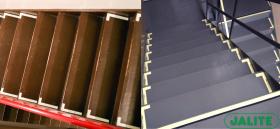
Inspections Required in NYC High Rises
Inspections Required in NYC High Rises Years after the tragic events on 9/11, the New York City Council enacted Local Law 26 in order to make New York City's tall buildings safer. The law requires that building owners install photoluminescent exit signs and marking at every exit door, pathway, and stairs. The law also requires that building owners perform an annual inspection of their egress pathways and keep a record of these inspections. It has now been some time since Local Law 26 was enacted Has your building performed its annual inspection within the last year? Did your photoluminescent system pass in its most recent inspection? Look no further than JALITE to supply you with what you need to bring your facility into compliance. As the first approved manufacturer of compliant products and the leading manufacturer to help write the code, you can be assured that JALITE Compliant is not only Code Compliant™ but will service well. Contact JALITE today to find out about inspection services and installations to meet the photoluminescent egress path requirements of Local Law 26.

How Can You Keep First Responders Safe?
How Can You Keep First Responders Safe? Words cannot express the importance of first responders. Every day over half a million calls are made to 9-1-1, calls which often bring first responders into action. Employees calling in an emergency at the workplace know the layout of the building, but it is more often the responders first time at the location. It is the responsibility of a business owner to ensure the safety of not only everyday occupants of the building, but also first responder in the event of an emergency. Communicating hazards is key to the safety of both workers and first responders. “Put Yourself in Our Boots” is a campaign that emphasizes how crucial it is that business owners create a safe work environment. Their videos portray how treacherous a lack of communication can be for first responders, most of who are already being placed under deadly circumstances. Traditional safety signs don’t communicate their message very well in an emergency. One way to keep first responders safe, is to communicate safety hazards in your facility using Jalite photoluminescent safety signs. When the lights go out, ours go on.™ For more information on a distributor near you send us an email.
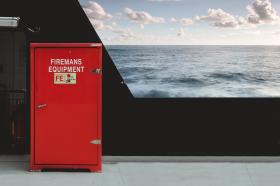
Fire Control Plan Symbol Signs
Fire Control Plan Symbol Signs (FCS) Fire Control Plan symbol signs are available from JALITE with full Class C luminance performance providing highly visible markings for fire control equipment in case of emergency. JALITE Fire Control Plan Symbols (FCS) are signs relating to symbols for fire control plans and fire equipment location. The symbols are to be used in accordance with ISO 17631. Safety related signs are manufactured on photoluminescent material as required by standards and regulators for the marine industry. visit our JALITE dedicated Marine website www.jalitemarine.com
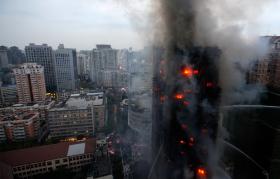
To Survive a Fire in a High Rise Building
To Survive a Fire in a High Rise Building The Best Advice to Give Your Loved Ones in a High Rise Building There are 15,400 high rise building fires each year in the US according to NFPA. What anyone who lives or works in a high rise must know is that the most important thing to do during a fire is to get out as soon as possible. Especially in a High Rise because of the longer egress times. That may seem obvious, but did you know that less than 50% of the survivors surveyed after the Sept. 11th attacks on the WTC reported that they evacuated immediately? For more information on the behavior of the survivors during their evacuation of the World Trade Center Towers, read the report by Guylene Proulx & Rita F. Fahy. In this report they mentions the use of photoluminescent markings which proved helpful in the evacuation: "Four survivors reported seeing photoluminescent stripes on the stairs, railings and stairwell doors – an improvement the Port Authority made following the 1993 bombing. As one survivor stated, “All you had to do was follow those yellow-green stripes. They were wonderful. The stripes were especially valuable when the emergency stairs stopped and people had to travel horizontally through mechanical equipment spaces that had many doors” (Masetti, 2001)." Whether it’s a traditional low rise building or a high rise building (skyscraper), whether occupant leave immediately or wait, it is imperative that they be able to see their way out. Jalite photoluminescent egress markings and signs will light the way out for any building. Contact us to find a distributor near you.
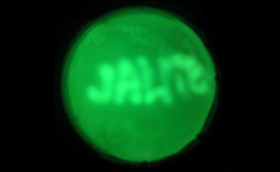
Strontium Aluminate
The arrival of new pigments in the 1990's has led to exciting developments for our industry. These new pigments based on alkali earth aluminates doped with rare earth elements have produced the tools for JALITE to design and produce a full range of products to meet all means of escape needs. This New and advanced technology has allowed JALITE to introduce JLUME photoluminescent materials that produce exceptionally long luminance decay characteristics compared to standard photoluminescent materials. These materials are suitable for high risk areas where egress may be slow or where light levels are lower. JLUME Plus is now well progressing and JALITE will be pushing Standards further for Class E materials in 2006 and for future F and G classes as technology and economics improve. JALITE uses its own proprietary technology for pigments and is fully licensed to use patented technology in the field. Users of high performance photoluminescent materials should assure themselves that any suppliers can produce evidence that they are not infringing current patents, as the application in safety products is also claimed in current patents.